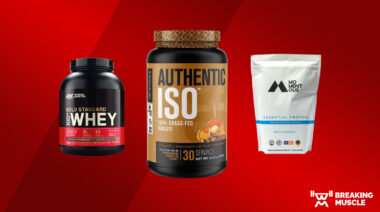I’d be a wealthy man if I had a nickel for every time I was asked how to prevent muscle cramps. Anyone who’s been woken up by a calf cramp understands why – it’s not a pleasant feeling. In a recent study in the Journal of Strength and Conditioning Research, investigators attempted to find the link between athletics and muscle cramps.
The researchers focused on cramps that occur as a direct result of athletics. As bad as nocturnal muscle cramps are, getting one in the middle of a game can be at best, a distraction, and at worst, a performance killer. The frequency of cramps seems to be higher in people who exercise. Not only that, but creatine consumption, which is common in athletes and recreational lifters, can also cause cramps.
The first recommendation you’ll often hear with cramping is to eat a banana, since they are high in potassium. This is due to the role of electrolytes in muscle contractions. The second recommendation is usually to drink more water, especially if you use creatine. Since creatine is associated with muscle contractions and an increased need for water, this recommendation makes sense.
The researchers examined many variables to see if they correlated with muscle cramping. I was sad to see that the factor most commonly responsible for cramps, electrolyte status or consumption, was not one of the studied variables. However, the researchers did study a number of other variables, including:
- Hydration
- Competition level
- Age
- Ethnicity
- Playing position
- History of cramping
- Pre-cramping
- Low back pain
- Foot orthotic usage
- Foot posture
- Foot strike
- Muscle flexibility
- Calf girth
- Number of games played
Rugby players were chosen as the studied athletic population. They were divided into two groups: those who had experienced at least one calf cramp during a game, and those who hadn’t. After taking all of the above data, the researchers correlated each factor to each group in an attempt to find associations.
There were three correlations found, but hydration wasn’t one of them. Perhaps more water only helps in the creatine crowd, if at all. The unsurprising result was that a history of cramping predicted more cramping. The other two factors were interesting, however.
- Athletic Level: You might expect calf cramps to decline with experience, due to greater resistance to the effects of exercise, but this was not so. The higher the level of athlete, the greater the incidence of calf cramps. You may also expect age to be a factor here, but it wasn’t. While this needs further study, it’s likely the result of the intensity of the matches at higher levels.
- Low Back Pain: A history of low back pain was the other predictor. The researchers examined other postural factors, such as foot posture and orthotic use, and only back pain was associated with cramping.
Until we have more banana research, it seems that exercise intensity and posture (or something like it) have the most to do with cramping. The former is something you’ll have to deal with if you’re a high-level athlete, but posture and back health are issues we all need to spend more time on. If you experience muscle cramps, it might be time for more posture work.
References:
1. Katherine Summers, et. al., “Predictors of Calf Cramping in Rugby League,” Journal of Strength and Conditioning Research, 28(3), 2014.
Photo courtesy of Shutterstock.






